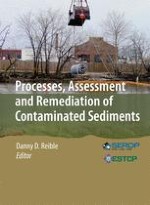2014 | OriginalPaper | Chapter
6. Assessing Biological Effects
Authors : Guilherme R. Lotufo, G. Allen Burton, Gunther Rosen, John W. Fleeger
Published in: Processes, Assessment and Remediation of Contaminated Sediments
Publisher: Springer New York
Activate our intelligent search to find suitable subject content or patents.
Select sections of text to find matching patents with Artificial Intelligence. powered by
Select sections of text to find additional relevant content using AI-assisted search. powered by
